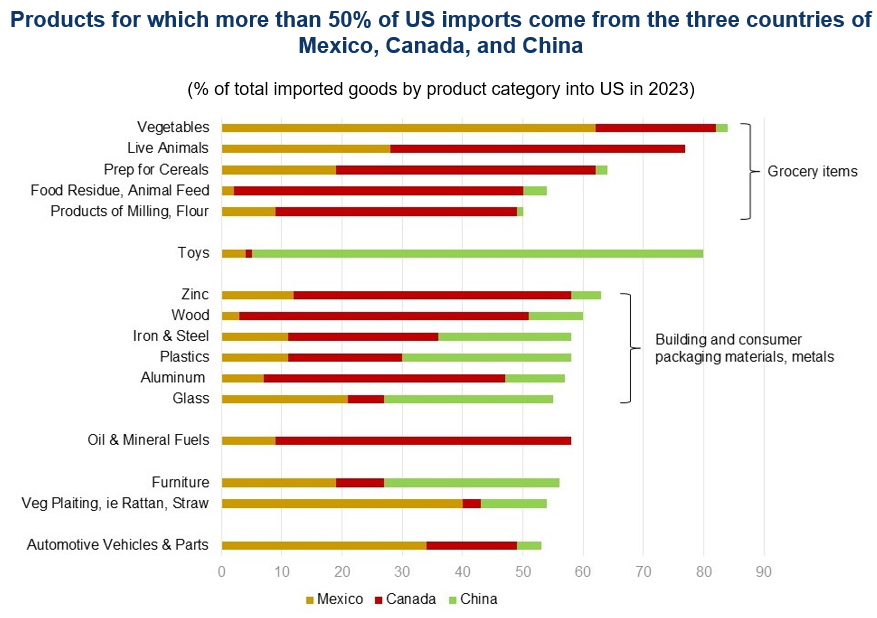
Levies were originally planned to start February 4, before the White House postponed the Mexico and Canada tariffs for 30 days. Canadian energy imports are expected to face a lower 10% rate. Bracing for impact: These tariffs impact a wide variety of US consumer and business goods. Together, goods from Canada, Mexico, and China make up 41% of US imports. The tariffs will have a significant impact on US grocery items, consumer packaging and building materials, automotive vehicles and parts, electronics, and manufacturing inputs including critical minerals. The US manufacturing industry has been bracing for tariffs, and the monthly Manufacturing ISM Report on Business released this week shows a contraction in the New Orders Index, as well as a surge in its Prices Index, now at its highest point since June 2022. An increase in prices is expected—at least in part—to be passed on to consumers. Growth and inflation fallout: The combined effects of the initially stated tariffs—25% each on Mexico and Canada, and 10% on China—could result in a 0.9 percentage point cut to US real GDP growth after four quarters, as well as a potential 0.6 percentage point rise in US inflation over four quarters. They will also lower GDP growth in the targeted economies. (For complete analysis, see our report US Tariff Plan Would Cut GDP Growth, Swell Inflation.) The Administration cited the need to invoke the International Emergency Economic Powers Act due to perceived threats posed by drugs and individuals entering the US illegally from these countries as the reason for the tariffs. The TCB take: Businesses should consider identifying alternatives for products and inputs—however, companies need to consider that this is a highly fluid situation and a schedule of reciprocal tariffs on the US’s 200+ trading partners is expected to be announced within the next couple of months. This has translated into a highly uncertain environment regarding the altering of supply chains.Tariffs on Three Largest US Trading Partners will Weaken Growth
Expect weaker economic growth in the US and for its three leading trading partners as 25% tariffs on goods imported from Mexico and Canada go into effect today. Additional 10% tariffs on China are also being implemented.

myTCB® Members get exclusive access to webcasts, publications, data and analysis, plus discounts to events.
September Inflation Pause Bodes Well for Fed Cut
December 05, 2025
September Retail Sales Show Consumers Taking a Breather
November 25, 2025
New Truce Offers Stability after US–China Trade Plummeted in 2025
November 05, 2025
Fed Signals It May Need to Pause
October 29, 2025
Fed Cut Amid Data Fog: What You Need to Know
October 28, 2025
CPI Details Give Green Light to Further Fed Rate Cuts
October 24, 2025
Charts
The proliferation of easy-to-use generative AI requires that policymakers and business leaders each play an important role.
LEARN MORECharts
A hyperpolarized environment, diminished trust in our nation’s leaders.
LEARN MOREIN THE NEWS
Denise Dahlhoff on How CEOs Are Talking About Tariffs—without Saying “Tarif…
May 21, 2025
IN THE NEWS
Erin McLaughlin on Tariff Policy
April 07, 2025
IN THE NEWS
Erin McLaughlin on Reshoring Factors
April 05, 2025
IN THE NEWS
Erin McLaughlin on US Reshoring
April 02, 2025
IN THE NEWS
Erin McLaughlin: How policy uncertainty may exacerbate infrastructure chall…
March 19, 2025
IN THE NEWS
Erin McLaughlin discusses the latest on tariff policy
March 14, 2025
